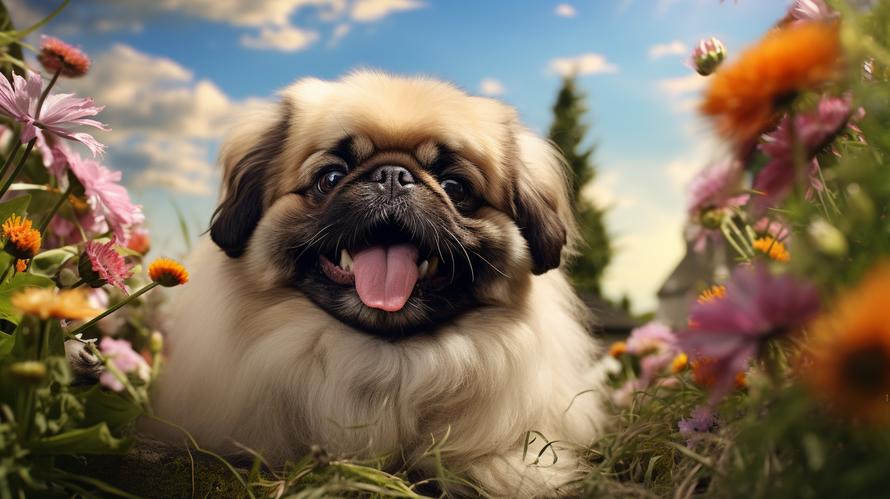The millennial cradle of civilization, the dynastic flower of ancient China, the handsome guardian of the royal family. Pekingese dogs have been famous and admired for their stylish hair coats, sturdy bodies, and a status that yells “Bow down!” just as much as their ancestors once did. Just one look at their sturdy little bodies and you’re already starting to fall in love. Exciting, isn’t it?
But, did you know that the beautiful Pekingese has a long ancestry that puts its diet under the direct order of Mother Nature, as great hunters and carnivores? Yes, undeniably, our furry friends are wild animals that humans decided looked like perfect cuddle buddies. The fascinating part is that this diet, dominated by meat, explains why your Pekingese might have been having those terrible allergic reactions currently worrying you.
As today’s top priority in your dog’s well-being, let’s unravel one of the most important questions you may have about your sweet Pekingese: Should it eat grain-free? Let’s dive into the captivating world of a dog’s diet.
A Grain of Truth in the Sea of Information
Grain-free diets seem to be all the rage these days, aren’t they? Everyone from your next-door neighbor to the gentleman in the dog park is moving towards a grain-free lifestyle. So, it begs the question, should your regal Pekingese join this health parade too?
Humans have been interacting with the nutritional needs of the Pekingese for centuries. Each strand of hair, each wag of that charming, adorable tail and that winning personality have been passed down through generations. With an imposing footprint in breed history stretching thousands of years back, the dietary requirements of Pekingese have been primarily shaped by their hunter-gatherer phase.
Grain consumption in dogs might lead to allergies causing itchy skin and upset stomachs. Pekingese are no different with reports of inflammation or infection, sometimes weight gain, or even an uncomfortable case of gas. But switching to a grain-free diet comes with its own risks including potential for heart disease. Too much of a good thing is bad, you know. A well-rounded, moderate approach where dogs get a combination of grains, proteins, and other nutrients may provide a safer, healthier diet.
So, what should we do? Let’s dive deeper into this as we strive to provide our regal Pekingese with the diet they deserve.
A Grain Free Diet?
The term ‘Grain-Free’ must be tickling your curiosity. What does it mean? Is it the ideal diet for your handsome Pekingese? Grain-free dog foods are just that: free of grains. They primarily consist of meats, fruits, vegetables, and other non-grain products.
The growing popularity of grain-free diets stems from the ‘ancestral diet’ theory. In the wild, dogs primarily scavenged for meats rather than digging for plants and grains. Adherents to this theory believe that modern dogs should maintain a similar diet. However, since domestication, dogs have evolved to process some amount of grains too.
It is important to recognize that while some grains might cause an allergic reaction in your Pekingese, not all grains are harmful. It’s the quality, type and the quantity of grain that matters. Commonly used grains in dog food include corn, wheat, and soy, some of which are known allergens. However, including more digestible, fiber-rich whole grains such as brown rice, oatmeal or millet, in moderation can prove beneficial.
So, ‘grain-free’ isn’t synonymous with ‘allergy-free.’ The choice isn’t black or white, it’s about optimal balance for your Pekingese.
The Tail Wagging Benefits
A grain-free diet includes higher protein and meat content. This could help your Pekingese maintain a healthier weight, develop leaner muscles, provide more energy, and make them feel fuller longer. Some dogs have shown improved skin and coat health along with better breath too.
On the other end of the spectrum, a grain-free diet can be higher in fats and calories. It might also lack certain essential nutrients found in grains. Ironically, taking grains out of the equation entirely may be unhealthy too! Rather, quality and quantity of grains – combined with protein – should be the focus.
So, how do you make a choice that tailors to the dietary needs of your prized Pekingese?
Making an Informed Choice
You wouldn’t take health advice from random straphangers, would you? The same applies to your Pekingese’s diet. Deciding between grain and grain-free choices should begin with a visit to the vet.
A simple allergy test can reveal if your Pekingese is allergic to certain grains. Your vet will be able to recommend a balanced, nutritious diet that aligns with your dog’s specific needs.
Read labels— an open-ended term like ‘meat’ could encompass anything from chicken to beaver. The preference should be for dog food that mentions specific sources of meat and grains. Remember, it’s not a simple choice between protein and grains but finding an optimal balance.
Be a conscious pet parent of your royal Pekingese. Make informed and balanced dietary choices to help them lead a healthier, happier life. Your dog’s diet should be as unique as their aristocratic lineage.
In the end, whether your Pekingese should go grain-free or not, isn’t strictly a ‘yes’ or ‘no’ answer. It’s part of a broader discussion about their overall diet, needs and health history. But nobody said nutrition was a walk in the dog park! The study and understanding of nutrition is a lifelong process, for both humans and our beloved pets.
With this kernel of knowledge about grains and Pekingese, you are now better equipped to make an informed decision about your pet’s health. The journey of understanding what’s best for our pets can feel like a long, winding road. But remember, at every turn, you’ll find love tail-wagging its way back to you. For a healthier, happier, and more energetic Pekingese, understanding their dietary needs and feeding them accordingly is a worthwhile venture.



